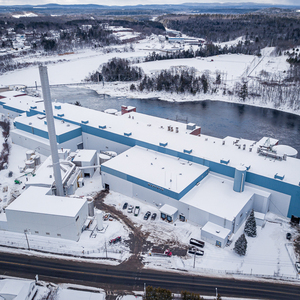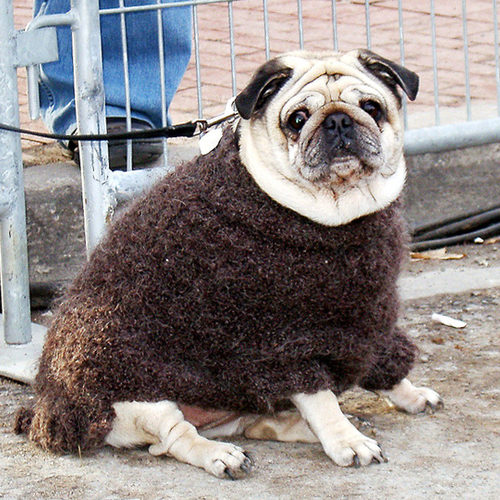
A Maine-based startup hoping to expand the wood fiber insulation market in the U.S. is in the process of buying a shuttered paper mill and hopes to start production of batt, board and blown in insulation next year.
GO Lab, a spinoff of GO Logic in Belfast, Maine, is plunking down roughly $2.5 million for the Madison Paper Industries mill that was closed in 2016 amid the slow deflation of the state’s pulp and paper industry, according to The Portland Press Herald.
Matt McConnell, director of market development, said in a telephone call that the company has purchased used equipment from Germany and can begin setting up a production line as soon as a paper-making machine has been disassembled and removed.
Insulation made from wood fiber is fairly common in Europe but it’s a relatively expensive and hard-to-find product in the U.S. There are only two known retailers in the country — 475 High Performance Building Supply in New York, which sells German-made Gutex, and Global Wholesale Supply, a Maryland-based company that distributes Steico insulation, which is manufactured in Poland. GO Lab would become the first producer in the country.
In an interview with GBA in 2017, GO Lab CEO Josh Henry said that wood fiber insulation will make an appealing alternative to rigid foam because it’s made from wood fiber rather than petrochemicals, can be recycled, and can be manufactured sustainably from Maine’s abundant wood fiber resources. Like rigid foam or mineral wool, it can be applied in a continuous layer on the outside of a building to reduce thermal bridging through the structural framing. Fiberboard insulation is not a structural component.
GO Lab hopes to sell the insulation both to lumberyards and to insulation distributors and contractors. Distribution will be mainly in the Northeast, McConnell said, but the company would ship it to buyers elsewhere.
Factory site is in the heart of paper country
Madison, Maine, is a town of about 4,800 in the rural midsection of the state. The mill’s closure in 2016 was part of an industry contraction that saw the number of mills decline and employment fall from its peak of 18,000 workers in the 1960s. The downward trend followed lower demand for newsprint and the type of glossy magazine stock the Madison mill produced.
The end of paper making in Madison was a blow to the community. Two hundred and fourteen people lost their jobs, and the town lost its biggest taxpayer.
But wood products, including paper, remain an important part of Maine’s economy and cultural identify. Industry officials look to non-traditional means of using the state’s forest resources to bring jobs back. If GO Lab can get its business off the ground and make good on Henry’s goal of hiring 110 people, it would be good news on Main Street.
GO Lab has been looking for private sources of money, and won a $100,000 grant last year through the U.S. Environmental Protection Agency. Then, earlier this month, the company was awarded another $750,000 grant, this one from state sources.
McConnell said the company is “feverishly” raising money and would need between $60 million and $65 million to get the operation off the ground. “We’re getting good traction,” he said.
So far, a niche product here
Fiberboard insulation will appeal to builders who want to avoid any type of foam in their roof and wall assemblies. European builders apparently like it, but U.S. builders don’t have ready access to it, and it’s considerably more expensive than rigid foam.
Gutex Multitherm 40 (R-5.8) costs about $1.80 per square foot — nearly three times as much as 1 1/2-inch-thick EPS with the same R-value — and it comes in an odd size that is incompatible with the 4-foot grid used by U.S. builders (although the tongue-and-groove design means seams don’t have to land on framing members).
Gutex Multitherm, meant for application on exterior walls, is sold in thicknesses ranging from 1 9/16 inches to 7 7/8 inches, with R-values from 5.8 to 29.1 respectively. The composition of Multitherm is 1% paraffin, 4% polyurethane, and 95% wood. It has an R-value of 3.7 per inch and a perm rating of 44 in a 1-inch thickness.
Steico’s competing product, called Steico Universal, comes in a variety of thicknesses, with 40 mm (1.57 inches) and 60 mm (2.36 inches) the most popular here, according to a company spokesman. It’s R-value is about 3 per inch, with standard sheets sold here about 7.2 feet by 2.5 feet.
McConnell said that the company hopes to get the price of fiberboard down so that it’s only slightly more expensive that extruded polystyrene (XPS).
As much as current fiberboard retailers like the product, they recognize that it isn’t likely to dethrone rigid foam or fiberglass. “We’re not going to make this a mainstream product,” said Will Grupenhoff, vice president for business development at Global Wholesale Supply. “It’s not going to be a product that winds up in Home Depot.”
But both Grupenhoff and Ken Levenson, 475’s chief operating officer, look forward to a growing market for the product in the U.S. as interest in healthy, low-carbon buildings gains a wider audience.
“Like Passive House and all the players in Passive House, whether you’re window suppliers or airtightness [product] suppliers or insulation suppliers, all these different efforts to grow the market and the availability of these products is going to help everyone,” Levenson said. “It’s going to make a more dynamic and more mature industry to serve the market.”
Levenson said that fiberboard insulation is a good fit with mass timber construction because it uses waste that would otherwise be burned or used in another product with a shorter carbon cycle. “It’s real value added in terms of the climate fight in that way,” he said. Other benefits include excellent sound attenuation and workability.
This post was updated on April 24.
Weekly Newsletter
Get building science and energy efficiency advice, plus special offers, in your inbox.














14 Comments
> Fiberboard is not a structural component.
I'd say "may or may not be a structural component".
Jon,
I agree. Part of the problem may be casual use of the word "fiberboard." I think that the product discussed in this article is more properly called "wood fiber insulation."
There are at least three U.S. manufacturers of structural fiberboard (as distinct from wood fiber insulation):
International Bildrite
101 Fourth Street East
International Falls, MN 56649
218-283-3900
http://www.bildrite.net/sheathing.htm
Manufacturer of BraceRite sheathing
Georgia-Pacific
Stedi-R structural sheathing and QuietBrace structural sheathing
http://www.gp.com/build/product.aspx?pid=6056
Homasote Company
PO Box 7240
West Trenton, NJ 08628-0240
http://www.homasote.com/
Sadly:
https://www.ifallsjournal.com/news/local/bildrite-ceases-operation/article_1001b7e1-0426-5c10-8568-cdf43b6bdc48.html
David,
Thanks for the link. It's unfortunate news -- structural fiberboard is a useful product for builders who prefer vapor-permeable sheathing.
Martin,
GP closed its plant as well a few years ago as well.
Will
Will,
Another sad piece of news. Thanks for the update.
Very interesting. Much of the background you described would apply equally here in Oregon: a rich timber history and shuttered mills in areas of the state starved for jobs. I'd love to see this successful and another operation start-up here.
I second that!!
I think it is important to note that these types of insulation can be carbon negative and given the time value of the carbon footprint of our buildings perhaps profoundly important.
Mela,
Can you expand on why fibreboard would be considered carbon negative?
Malcolm, wood fiber made from sustainably-harvested forests using the modern, "dry" method does not take an enormous amount of energy, and it sequesters carbon that would otherwise return to the growth/decay system. Some experts (such as Floris from 475) have calculated that they can make wood fiberboard in Europe, ship it to North America and it can still save more carbon (through energy savings) than it took to create it. Once GO Labs' plant is up and running here in Maine, fed with FSC-certified wood pulp, it will be a no-brainer to use it if you care about carbon emissions.
Michael,
I hope a plant opens up here on the West Coast soon. Our climate here is too mild to justify double walls. A layer of fibreboard would be perfect.
Malcolm, I got the impression that once the plant here is running that we will see more popping up around the continent. Double stud construction barely makes sense here in Maine; once wood fiber is affordable and easy to get locally I think we'll see CEI become the standard approach.
Yesterday's BS and Beer show nudged me to bump this conversation.
I was disappointed to learn that North American made wood fiber insulation will not be available before the end of 2022. Timber HP is scheduled to start production at a former paper mill in Main. Their insulation product claims to be carbon negative. I was not able to find an EPD to confirm GWP for their products.
Carbon negative is referring to the carbon sequestered by the tree and stored in the insulation material. A European wood fiber insulation environmental product declaration states:
"The Global Warming Potential (GWP) has a particular significance in terms of wood products: by absorbing carbon dioxide during photosynthesis, a negative GWP is achieved during manufacturing of the auxiliaries and product despite CO2 emissions. The bound carbon dioxide is not released until thermal utilization at the End of Life, whereby the credit for energy is so high that the CO2 emissions display a lower value during combustion. The primary effect of the global warming potential is caused by carbon dioxide."
Not all EPDs of European wood fiber insulations products show negative GWP. Products manufactured in a dry process generally appear to have a lower or negative GWP. Timber HP will deploy a dry process.
In the absence of locally manufactured wood fiber insulation a European product could be used. What is the carbon balance after shipping (expressed in CO2eq GWP)?
Shipping to North America:
To calculate the GWP attributable to shipping a carbon negative insulation product from a manufacturing plant in Southern Germany to a construction site in Southern California this calculator has been used:
https://kuhnenagel.ecotransit.org/kuehnenagel/ to establish GWP of approx. 1,000kgCO2eq/TEU. Approx. 23cubic meter of board insulation fit a 20' container.
Assuming a GWP of -119kgCO2eq/m^3 for German dry process wood fiber insulation board and shipping GWP of 43.5kgCO2eq/m^3 would result in a GWP of approx. -75.5kgCO2eq/m^3 of insulation. Wood fiber insulation can be carbon negative even after traveling 10,000miles. This compares very favorably with any US made synthetic board insulation material.
Shipping assumptions: FCL shipping only. Manufacturing plant to closest major container rail hub via diesel truck 120miles, container rail to seaport 420miles, diesel truck from port to construction site 120miles.
Shipping Timber HP's insulation material via sea to California may still result in a carbon negative insulation material if it has a similar or lower GWP than a product made in Germany.
In the meantime every effort should be made to substitute synthetic board insulation materials with imported wood fiber insulation board. The project specific shipping GWP should be verified with FCL shipping as the preferred method.
Log in or create an account to post a comment.
Sign up Log in